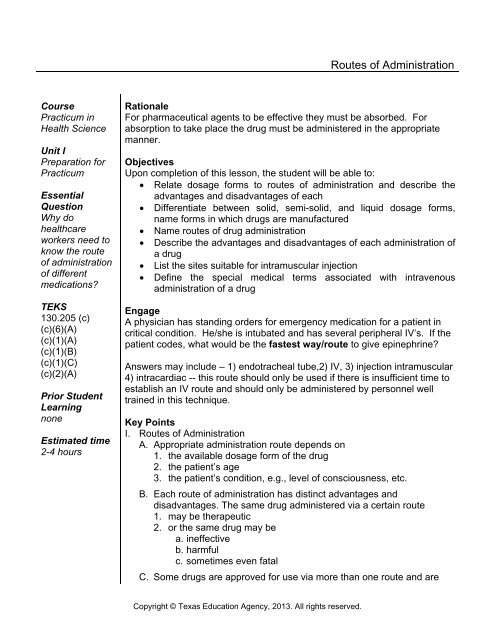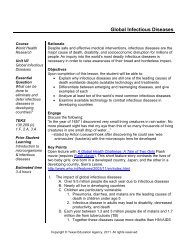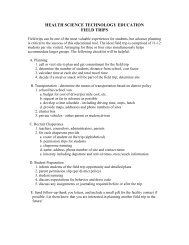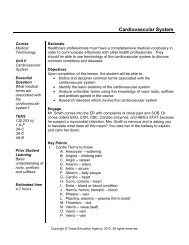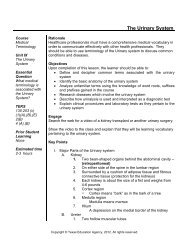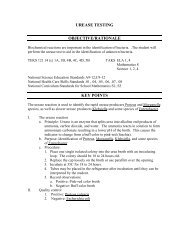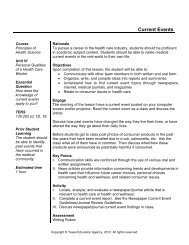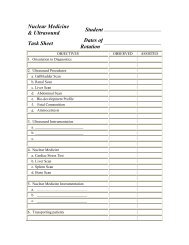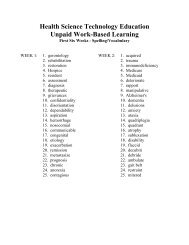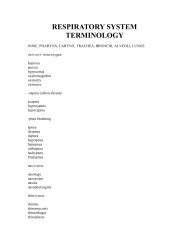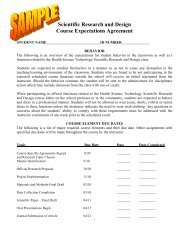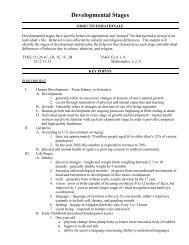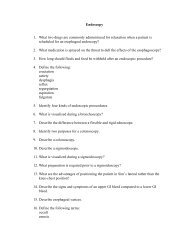Routes of Administration
Routes of Administration
Routes of Administration
Create successful ePaper yourself
Turn your PDF publications into a flip-book with our unique Google optimized e-Paper software.
<strong>Routes</strong> <strong>of</strong> <strong>Administration</strong>CoursePracticum inHealth ScienceUnit IPreparation forPracticumEssentialQuestionWhy dohealthcareworkers need toknow the route<strong>of</strong> administration<strong>of</strong> differentmedications?TEKS130.205 (c)(c)(6)(A)(c)(1)(A)(c)(1)(B)(c)(1)(C)(c)(2)(A)Prior StudentLearningnoneEstimated time2-4 hoursRationaleFor pharmaceutical agents to be effective they must be absorbed. Forabsorption to take place the drug must be administered in the appropriatemanner.ObjectivesUpon completion <strong>of</strong> this lesson, the student will be able to: Relate dosage forms to routes <strong>of</strong> administration and describe theadvantages and disadvantages <strong>of</strong> each Differentiate between solid, semi-solid, and liquid dosage forms,name forms in which drugs are manufactured Name routes <strong>of</strong> drug administration Describe the advantages and disadvantages <strong>of</strong> each administration <strong>of</strong>a drugList the sites suitable for intramuscular injectionDefine the special medical terms associated with intravenousadministration <strong>of</strong> a drugEngageA physician has standing orders for emergency medication for a patient incritical condition. He/she is intubated and has several peripheral IV’s. If thepatient codes, what would be the fastest way/route to give epinephrine?Answers may include – 1) endotracheal tube,2) IV, 3) injection intramuscular4) intracardiac -- this route should only be used if there is insufficient time toestablish an IV route and should only be administered by personnel welltrained in this technique.Key PointsI. <strong>Routes</strong> <strong>of</strong> <strong>Administration</strong>A. Appropriate administration route depends on1. the available dosage form <strong>of</strong> the drug2. the patient’s age3. the patient’s condition, e.g., level <strong>of</strong> consciousness, etc.B. Each route <strong>of</strong> administration has distinct advantages anddisadvantages. The same drug administered via a certain route1. may be therapeutic2. or the same drug may bea. ineffectiveb. harmfulc. sometimes even fatalC. Some drugs are approved for use via more than one route and areCopyright © Texas Education Agency, 2013. All rights reserved.
2. provides for more rapid absorption than via subcutaneous injection3. only five intramuscular injection sites that allow for administrationwith lowest risk <strong>of</strong> damage to adjacent nerves and blood vesselsa. deltoid – located on upper arm, lateral aspectb. vastus lateralis – located on midthigh, lateral aspectc. rectus femoris – located on midthigh, anterior aspectd. ventrogluteal – located on the side <strong>of</strong> the hip over gluteusmuscle between anterior and superior spines <strong>of</strong> the iliac creste. dorsogluteal – located over gluteus minimus and edge <strong>of</strong>gluteus maximus muscles in upper outer quadrant4. some drugs are not water soluble and would precipitate out inmuscular tissue, therefore are not acceptable to be administeredintramuscularly, e.g., Valium, LibriumD. Intravenous – injection <strong>of</strong> drug directly into the vein1. therapeutic effect can be seen immediately2. drug does not need to be absorbed3. examplesa. Pentothal for induction <strong>of</strong> general anesthesiab. Valium for control <strong>of</strong> continuous epileptic seizuresc. chemotherapy drugs for cancer treatmentd. antibiotics in high dosages4. i.v. or I.V. injection can be accomplished in three waysa. I.V. push -- the administration <strong>of</strong> a drug bolus by injecting asingle dose <strong>of</strong> drug directly into the vein or through a port(rubber stopper) into an existing intravenous line in a veryshort timeb. I.V. drip -- mixing the drug with fluid in an I.V. bag or bottle tobe administered continuously over several hoursc. I.V. piggyback – mixing the drug in a very small I.V. bag orbottle connected through tubing to a port in the existingprimary I.V.E. Sublingual – the drug, usually in tablet form, is placed under thetongue and allowed to dissolve slowly1. the tablet is NOT swallowed.2. the drug is absorbed quickly through oral mucous membranes intothe large blood vessels under the tongue.3. sublingual application provides a faster therapeutic effect than theoral route, e.g., nitroglycerin tablets and spray for anginaF. Rectal – reserved for certain clinical situations, such as a vomitingpatient and medication not available in injectable form, e.g., Tylenol.1. preferred route when drugs are administered to relieveconstipation or hemorrhoids2. absorption via rectal route slow and <strong>of</strong>ten unpredictable ineffectivenessG. Vaginal – used to treat vaginal infections and vaginitis with creamsand suppositories, e.g., Monistat suppositories, Premarin vaginalCopyright © Texas Education Agency, 2013. All rights reserved.
cream; also route <strong>of</strong> administration for vaginal contraceptive foamsand gelsH. Topical – applied directly to the skin or the mucous membranes <strong>of</strong> theeye, ear, nose, or mouth1. effect usually local, not systemic, e.g. bacitracin antibioticointment, Sudafed nasal decongestant, Timoptic eye dropsI. Transdermal – applied to the skin via physical delivery through aporous membrane, e.g. nitroglycerin transdermal patch1. therapeutic effects felt systemically2. usually releases drug slowly over time, providing sustainedtherapeutic blood levelsJ. Inhalation – administration involves inhaling <strong>of</strong> a drug in gas or liquidform; drug is absorbed through alveoli <strong>of</strong> the lungs, e.g. nitrous oxidefor general anesthesia, Proventil (albuterol) bronchodilatorActivityI. Complete the <strong>Routes</strong> <strong>of</strong> <strong>Administration</strong> Worksheet.II. Identify sample pharmaceutical agents as to dosage form andprescribe the correct route <strong>of</strong> administration for each.III. Write and perform a skit <strong>of</strong> a dosage form and its route <strong>of</strong>administration: “The Journey <strong>of</strong> a Pharmaceutical Agent.”IV. Design posters depicting various routes <strong>of</strong> administration or produce athree-dimensional model with proper labelingAssessmentPerformance <strong>of</strong> skitProject RubricMaterialsContainers for Samples <strong>of</strong> OTC meds for students to identify dosage formsand routesDrug references, e.g., PDR, etc.<strong>Routes</strong> <strong>of</strong> <strong>Administration</strong> WorksheetAccommodations for Learning DifferencesFor reinforcement, the student will design a comparative chart listing dosageforms, their appropriate route <strong>of</strong> administration, advantages anddisadvantages <strong>of</strong> each, and examples <strong>of</strong> drugs for each.For enrichment, the student will develop a teaching video demonstratingappropriate methods <strong>of</strong> pharmaceutical agent administration for the differentroutes <strong>of</strong> administration.National and State Education StandardsNational Health Care Foundation StandardsFoundation Standard 3: SystemsCopyright © Texas Education Agency, 2013. All rights reserved.
Healthcare pr<strong>of</strong>essionals will understand how their role fits into theirdepartment, their organization and the overall healthcare environment. Theywill identify how key systems affect services they perform and quality <strong>of</strong> care.Accountability Criteria3.1 Healthcare Delivery Systems3.11 Understand the healthcare delivery system (public, private,government, and non-pr<strong>of</strong>it).3.13 Describe the responsibilities <strong>of</strong> consumers within the healthcaresystem.3.14 Explain the impact <strong>of</strong> emerging issues such as technology,epidemiology, bioethics, and socioeconomics on healthcare deliverysystems.Foundation Standard 7: Safety PracticesHealthcare pr<strong>of</strong>essionals will understand the existing and potential hazardsto clients, co-workers, and self. They will prevent injury or illness throughsafe work practices and follow health and safety policies and procedures.Accountability Criteria7.3 Environmental Safety7.31 Apply safety techniques in the work environmentTEKS§130.205(c)(1)(A) interpret data from various sources in formulatingconclusions;§130.205(c) (1)(B) compile information from a variety <strong>of</strong> sources to create atechnical report;§130.205(c) (1)(C) plan, prepare, and deliver a presentation;§130.205(c) (2)(A) accurately describe and report information, according t<strong>of</strong>acility policy, observations, and procedures;§130.205(c) (6)(A) integrate regulatory standards such as standardprecautions and safe patient handling;College and Career Readiness StandardsEnglish Language ArtsI. Writing2. Generate ideas and gather information relevantto the topic and purpose, keeping carefulrecords <strong>of</strong> outside sources.3. Evaluate relevance, quality, sufficiency, anddepth <strong>of</strong> preliminary ideas and information,organize material generated, and formulate athesis.III. SpeakingA. Understand the elements <strong>of</strong> communication both in informal groupdiscussions and formal presentations (e.g., accuracy, relevance, rhetoricalCopyright © Texas Education Agency, 2013. All rights reserved.
features, organization <strong>of</strong> information).1. Understand how style and content <strong>of</strong> spoken language varies in differentcontexts and influences the listener’s understanding.2. Adjust presentation (delivery, vocabulary, length) to particular audiencesand purposesB. Develop effective speaking styles for both group and one-on-onesituations.1. Participate actively and effectively in one-on-one oral communicationsituations.2. Participate actively and effectively in group discussions.3. Plan and deliver focused and coherent presentations that convey clearand distinct perspectives and demonstrate solid reasoning.IV. ListeningA. Apply listening skills as an individual and as a member <strong>of</strong> a group in avariety <strong>of</strong> settings (e.g., lectures, discussions, conversations, team projects,presentations, interviews).1. Analyze and evaluate the effectiveness <strong>of</strong> a public presentation.2. Interpret a speaker’s message; identify the position taken and theevidence in support <strong>of</strong> that position.3. Use a variety <strong>of</strong> strategies to enhance listening comprehension (e.g.,focus attention on message, monitor message for clarity andunderstanding, provide verbal and nonverbal feedback, note cues such aschange <strong>of</strong> pace or particular words that indicate a new point is about to bemade, select and organize key information).Cross Disciplinary StandardsI. Key Cognitive SkillsD. Academic behaviors1. Self-monitor learning needs and seek assistance when needed.2. Use study habits necessary to manage academic pursuits andrequirements.3. Strive for accuracy and precision.4. Persevere to complete and master tasks.E. Work habits1. Work independently.2. Work collaboratively.Copyright © Texas Education Agency, 2013. All rights reserved.
ROUTES <strong>of</strong> DRUG ADMINISTRATIONROUTEAPPROXIMATEONSET OFACTIONINDICATIONSEXAMPLESoral (PO, p.o.)whenever possible, safest andmost convenient routemost medications,e.g. analgesics,sedatives,hypnotics, antibioticsseveral minutesNTG (nitroglycerin)in angina pectorisbuccal (bucc.)androgenic drugsrectal (p.r.)when patients are unable totake oral medications andparenteralroute is not indicated,also forlocal effectconvenient dosage form,providescontinuous absorption andsystemiceffects over extended time(hours, days, etc.)nitroglycerin,estrogen,morphinesubcutaneous(sq, s.c., subq.,subcu)several minutesfor drugs with poor oralabsorption,when high blood levels arerequired,when rapid effect is desirednarcotic analgesicsantibioticsintravenous(i.v., I.V.)I.V. fluidsnutrientsupplementationantibioticsresuscitative drugsCopyright © Texas Education Agency, 2013. All rights reserved.
intraarterial (i.a.)for local effects within specifictarget organseveral minutesspinal anesthesiainhalationfor local effects within respiratorytractwithin 1 hourcreams, ointments,sprays, tinctures,lozengesvaginalcreams, foams,suppositoriesCopyright © Texas Education Agency, 2013. All rights reserved.
Key - ROUTES <strong>of</strong> DRUG ADMINISTRATIONROUTEAPPROXIMATEONSET OFACTIONINDICATIONSEXAMPLESoral (PO, p.o.)30 - 60 minuteswhenever possible, safest andmost convenient routemost medications,e.g. analgesics,sedatives,hypnotics,antibioticssublingual (s.l.) several minutes when rapid effect is desiredNTG (nitroglycerin)in angina pectorisbuccal (bucc.)several minutesconvenient dosage form forcertain drugs; may be used inunconscious patientsandrogenic drugsrectal (p.r.)15 - 30 minuteswhen patients are unable totake oral medications andparenteral route is not indicated,also for local effectanalgesics,antiemetics,laxativestransdermal30 - 60 minutesconvenient dosage form, providescontinuous absorption andsystemic effects over extendedtime (hours, days, etc.)nitroglycerin,estrogen,morphinesubcutaneous(sq, s.c., subq.,subcu)several minutesfor drugs that are inactivated ingastrointestinal tractinsulinintramuscular(i.m., IM)several minutesfor drugs with poor oralabsorption,when high blood levels arerequired,when rapid effect is desirednarcotic analgesicsantibioticsintravenous(i.v., IV)within 1 minutein emergency situations, whenimmediateeffect is desired, when largevolumesneed to be administered, e.g.infusionIV fluidsnutrientsupplementationantibioticsresuscitative drugsintraarterial (i.a.) within 1 minute for local effects within specific cancer drugsCopyright © Texas Education Agency, 2013. All rights reserved.
target organintrathecalseveral minutesfor local effects within the spinalcordspinal anesthesiainhalationwithin 1 minutefor local effects within respiratorytractantiasthmaticsbronchodialtorstopicalwithin 1 hourfor local effects on skin andmucousmembrane <strong>of</strong> eye, ear, nose,mouthcreams, ointments,sprays, tinctures,lozengesvaginal 15 - 30 minutes for local effectcreams, foams,suppositoriesCopyright © Texas Education Agency, 2013. All rights reserved.
Project RubricStudent: ________________________Date: ___________________________Scoring criteria4.Excellent3.Good2. NeedsSomeImprovement1. NeedsMuchImprovementN/AClearly/effectively communicates the main idea ortheme.Reflects application <strong>of</strong> critical thinking.Information clearly provided in an organized andthoughtful manner.Strong examples used to describe the theme orobjective.Illustrations follow a logical reasoning.Each image and font size is legible to entire audience.No spelling, grammatical or punctuation errors.NOTE: N/A represents a response to the performance which is "not appropriate."Copyright © Texas Education Agency, 2013. All rights reserved.


